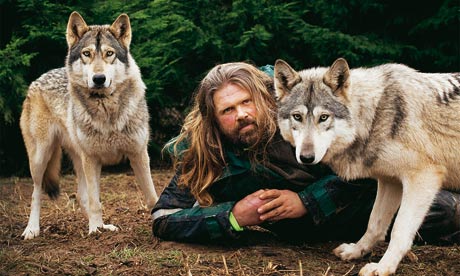Saturday 29 January 2011
Thursday 27 January 2011
Saturday 22 January 2011
Experience: I lived with wolves
http://www.guardian.co.uk/lifeandstyle/2011/jan/15/i-lived-with-wolves

Like most young children, I grew up with an innate fear of wolves. It wasn't until I was a bit older and saw a wolf in a zoo that I realised how far away this animal was from the mythological creature I'd learned about in books and films.
I grew up in a small village in Norfolk and was always interested in the natural world and wild animals. I knew I wanted to work with them in some way when I was older. In my 20s, I read about an American naturalist, Levi Holt, who ran a wolf research centre in Idaho and I thought, "That's where I want to go." I sold everything I had and raised enough money for my plane fare. When I met up with biologists working on the reservation, they took me on as a basic field biologist, teaching me how to track wolves and collect data for them.
Even though the other biologists and scientists thought it was dangerous, I soon wanted to get closer to the wolves really to understand their behaviour. I couldn't help wondering, "Could a human become part of their family?" If I could, I thought, imagine what information I could share.
After a year or two of working for the centre and getting to know the area – a rugged, mountainous landscape covered in forest – I moved to the wild. The first time I got up close to a wolf, within around 30 metres, any fear I had quickly turned to respect. I stayed in a den area, a remote spot where wolves look after their young, and very soon one pack began to trust me. I lived with them day and night, and from the start they accepted me into their group. I ate what they ate, mostly raw deer and elk, which they would often bring back for me, or fruit and berries. I never fell ill and my body adapted quickly to its new diet. It's easy to look back and think, "What horrible food", but when you haven't eaten for a week, it looks appetising.
I couldn't hunt, but I soon became useful looking after the younger ones. I would spend days sitting outside the den, observing their behaviour and trying to make sure they kept out of danger.
I stayed with the same pack for over a year, watching pups grow to adulthood. I never missed human contact during that time.
I felt a tremendous sense of belonging with the wolves. Whenever I began to think about my old life, I would quickly switch my thoughts back; in terms of survival, I had constantly to focus on my new habitat. Although I didn't see anyone, there were people back at the reservation and I had a rendezvous point where I could leave messages if I felt I was in danger. I was only ever truly scared on two occasions: once, when all the wolves were feeding, I ate the wrong piece of meat – there is a strict hierarchy of who eats what part of an animal – and one of the wolves leapt on me in seconds because of my mistake. He took my entire face in his mouth and started to squeeze hard. I could feel the bones in my jaw begin to bend, and in that split-second I realised how vulnerable I was and how restrained they were most of the time.
The other time, I wanted to get a drink from the stream and one of the wolves stopped me dead in my tracks, growling, snarling and nipping me. I thought, "This is the end, he's going to finish me off." An hour or so later, he started to lick my face and we both went to the stream for a drink. There I saw evidence of recent bear tracks and droppings, and I realised this was why he guarded me. I would almost certainly have been killed but, more importantly, my tracks would have led back to their young, so it was for their protection.
Eventually I had to leave; I had lost so much weight and looked gaunt and worn after a year . Life expectancy in that sort of environment was short and I felt it was time to come back to society. Returning to the world was a tremendous culture shock, but I knew I could do a lot with the knowledge I'd acquired. I now run a centre in Devon that helps wild and captive wolves, and offers educational courses. I want to show people that wolves aren't savage and ruthless – they are balanced and trustworthy creatures that place their family above all else.
• As told to Fiona Clampin.
Wednesday 19 January 2011
Matthew HArding
''The simple beauty of the phyllotaxis spiral is at once a highly complex but everyday phenomenon found in plant life around the globe—from the arrangement of leaves on stems to the radiating centre of a sunflower. It is a reminder of the mathematical intricacies of nature.
Despite the exponential growth in our knowledge of the macro and micro worlds, our understanding has made us more aware of our tenuous hold on existence. We are like Cook or Columbus, at sea on a clear moonless night where the horizon dissolves into an endless mirror of stars; or weightless like Armstrong with a small blue sphere in the cradle of his hand. Our scale and position are at the same time insignificant and pivotal. Understanding changes everything.
This work acknowledges the fact that although I can try to recreate, manipulate or interpret this pattern for a wide audience, it is only a tiny piece of the huge evolutionary puzzle all around us, as mirrored in each dome’s surface. The fisheye reflections place us at the centre of our observation.
I often employ natural geometries such as concentric circles, logarithmic and phyllotactic spirals as part of a visual system or structural language. These explorations and observations serve to reinforce an aesthetic appreciation of the underlying principles, laws and geometries that govern, inform and shape our world. Creativity is a natural language to humans—we reshape the nature of the world around us and in turn the world reshapes us.
Matthew Harding, December 2002''
Saturday 1 January 2011
Chia: Rediscovering a Forgotten Crop of the Aztecs
''Close to 1.4 million living species have been identified. The major ones are 750,000 insects, 41,000 vertebrates, and 250,000 plants. The remainder are invertebrates, mushrooms, algae, and microorganisms (Wilson, 1988). Almost 3,000 plants have been investigated for food or for other uses; however, just 100 have been studied in depth. Throughout time humans have tended to concentrate on obtaining nourishment from a few plants. Today, only 150 plant species are cultivated, twelve of them providing approximately 75 percent of our food. Four of them produce more than half of the food consumed. Most people in the world are fed with cereals such as wheat, rice, millet, and sorghum; tubers such as potatoes, sweet potatoes, and cassava; legumes such as beans, soybeans, and peanuts; and other crops such as sugarcane, sugar beets, cocoa, and bananas (National Research Council, 1975; Harlan, 1992) In 1992 the Genreal Director of the food and agriculture Organization alerted the world to this backward evolution and said that as a result human nutrition was suffering. He also pointed out that the vulnerability of agriculture was increasing and that humans were in danger, as they had only a few sources from which to obtain food (Vietmeyer, 1978; Saouma, 1992). The human food supply now depends on a small number of species, and the failure of one of them could mean starvation for millions of people........People have become very dependent upon cereal grains. Hunter Gatherers ate more than 100 species of plants and animals in the course of a year. Modern humans depend on barely twenty sepcies of plants, four mammals cattle, sheep, pigs, and goats) and one bird (chicken) for the bulk of there nourishment. From the twenty plant species eaten, only four are cereals (wheat, corn, rice and barley), and these form 70 percent of modern western diets. This dependance on a few species puts Western civilisations in a very precarious situation if diseases or pests were to threaten any of these plants. Additionally, intensive medical and nutritional rsearch has demonstrated the importance a diversified diet has in maintaining human health Krauss et al.,2000 ''
''The United States in 1900 was predominantly rural, with nearly 40 percent of the population living on farms . By the 1990s only 1.9 percent of Americans were living in farm households (Beale, 2001).
With human evolution, changes in living were accompanied by changes in food. Modern diets are very different from those of closely related primates and almost certainly from those of early hominidsand preagricultural but anatomically modern humans who lived 30,000 years ago (Wadley and Martin, 1993). Humans have been on earth for 3-5 million years, and for than 99 percent of this time they lived as hunters and gatherers. Only in the last 10,000 years, from the neolithic to the present, did they domesticate plants and animals and transition to an agricultural lifestyle (Engel, 1987; Harlan, 1992). It has been estimated that the typical diet of the paleolithic period (2million-10,000 B.C.) consisted of 50 percent plant based foods and 50 percent from animal origin. Preagricultural foods came from wild game-such as deer, bison, horses, mammoths-fish, wild plants, whole grains, and honey, but no dairy products, oils, and salt were consumed (Cowan and Watson, 1992; Lichtenstein, 1999)
According to Simopoulos (1999a), the spontaneous mutation rate for DNA is estimated at 0.5 percent per million years. Therefore, during the agricultural period there has been little if any chsnge in human DNA. Most human evolution took place during the time of paleolithic diets; hence, genetically, humans remain adapted to a paleolithic diet (Wadley and Martin, 1993; Eaton and Eaton III, 1999, 2000). Data from archaeological findings support the concept that the genetic makeup of human beings as it exists today was developed by a paleolithic diet. Epidemiological studies and controlled experiments strongly support the need to return to that diet (Eaton et all.,1998; Simoplous, 198; Eaton and Eaton III, 2000)''
Fatty acids stimulate and maintain life functions in humans and are considered a macronutrient in human nutrition. In Western diets fatty acids generally constitute the major source of calories. On the other hand, in Asia and undeveloped countries carbohydrates provide the main caloric resource (Nelson. 1992). Fatty acids and there metabolic products serve three basic functions:
1. They act as a highly efficient ernergy reserve that provides protection against external agents like cold weather Mugli and clough, 194; Nettleton, 1995).
2. They are a fundemental constituent of celuar membranes, giving them an elsatic cover that protects each cell (muggli and Clough, 1994; Nettleton, 1995).
3. They act as precursors (i.e, they are the source) from which are made an imoprtant group of hormonal compounds called prostaglandins, thromboxanes, and leukotrienes, which are involved in many physiological processes associated with the central nervous system, hormonal functions, regulation of blood pressure, cholsterol transport, immunoligical mechanisms, and inflammatory reactions (American Heart Association, 1988; Welch and Borlakoglu, 1992; Muggli and clough, 1994; Nettleton, 1995)''




















